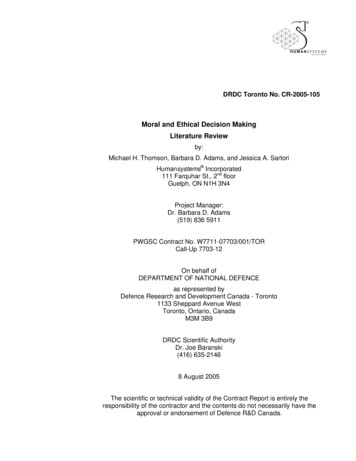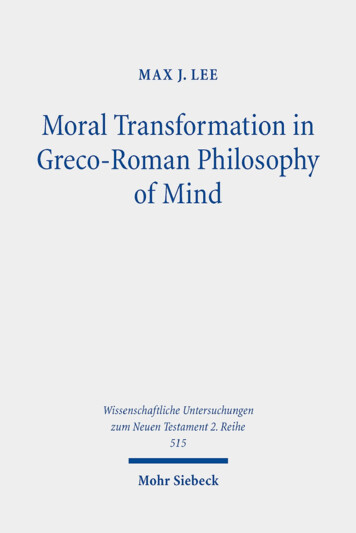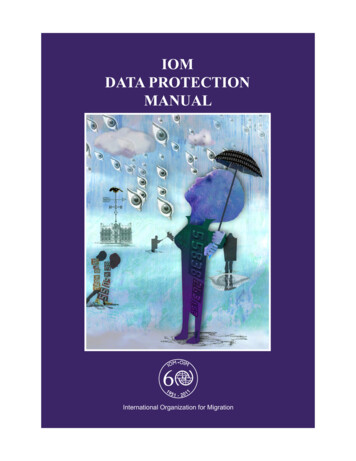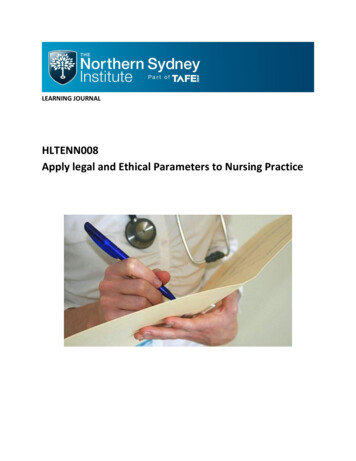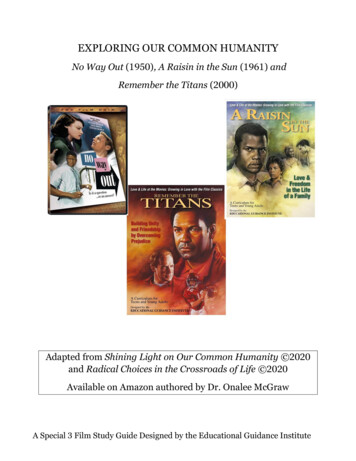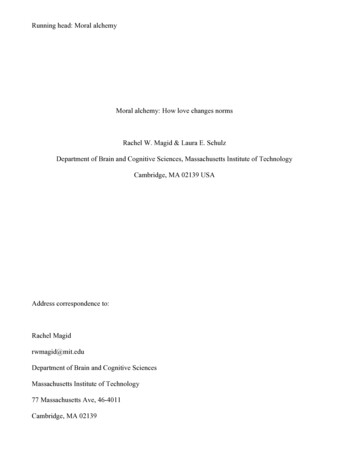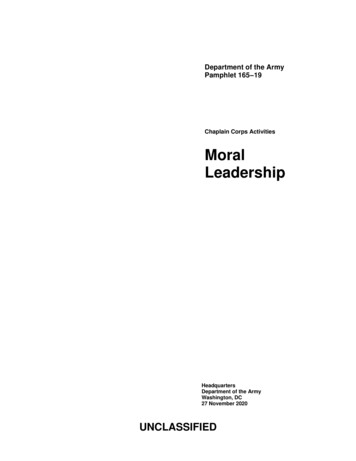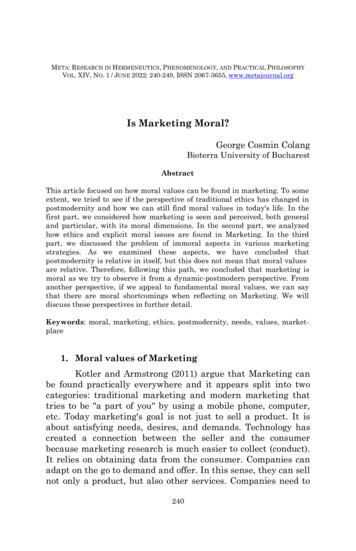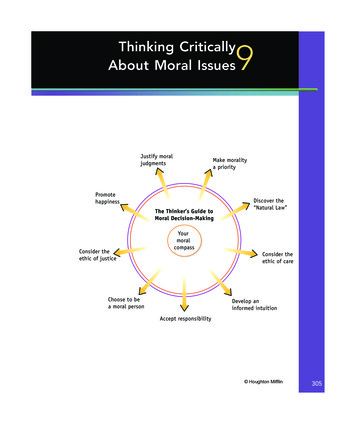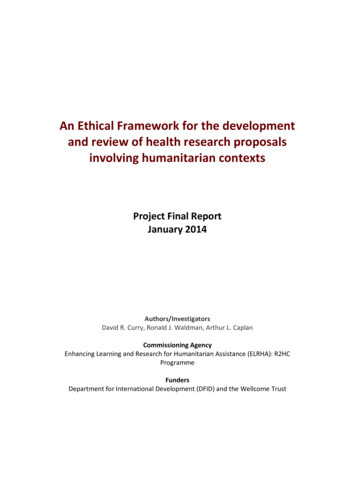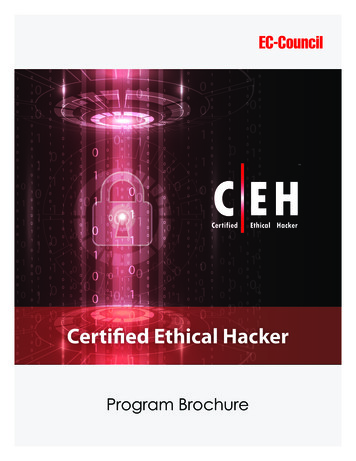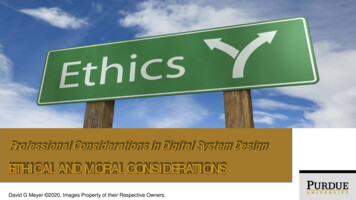
Transcription
Professional Considerations in Digital System DesignETHICAL AND MORAL CONSIDERATIONSDavid G Meyer 2020, Images Property of their Respective Owners.
OUTLINE Why study ethics?Code of ethicsBasic ethics questionsEthical conflictConsequences of unethical practicesEthics case studies
WHY STUDY ETHICS? Accreditation agencies (ABET) deem it a critical part of allengineering curricula, including EE and CmpE Virtually all professional societies have a code of ethics: IEEE Code of nce/p7-8.html ACM Code of Ethics:http://www.acm.org/about/code-of-ethics
CODE OF ETHICS Highlights from the IEEE Code of Ethics: “To accept responsibility in making decisions consistent with the safety,health, and welfare of the public, and to disclose promptly factors thatmight endanger the public or the environment” “To avoid real or perceived conflicts of interest whenever possible, and todisclose them to affected parties when they do exist” “To be honest and realistic in stating claims or estimates based onavailable data” “To avoid injuring others, their property, reputation, or employment byfalse or malicious action”
SOME BASIC ETHICS QUESTIONS What forms the basis of our views and our understanding of ethics? Why is ethical behavior important to society? What could happen if the issue of ethics was completelydisregarded? How can ethical practices best be learned, promoted, and ensured?
ETHICAL CONFLICT Duty/Responsibility vs. Malice/Indifference Example: FTDI counterfeit IC driver issue Duty vs. Self-Interest (“Conflict of Interest”) Examples: Bribery, misuse of position, mishandling classified orproprietary material, etc. Duty vs. Duty Maximize profit for employer vs. obligation to society Confidentiality vs. whistle-blowing
CONSEQUENCES Some consequences of unethical practices: Injury or loss of human life Loss of business contracts or customers Damage to a business’s image or reputation Fines and penalties Jail time What other consequences can you think of?
ETHICS CASE STUDIESBoeing 737 Max MCAS (Maneuvering Characteristics Augmentation System)The Setup: Boeing designed the 737 Max 8 to be similar enough to existing737s that it could keep the same “type rating” – so that pilots who already flew737s would not have to be retrained on a new plane (saving airlines asubstantial amount of money). But there was a major difference in the newMax 8: it featured larger engines (GE Leap) placed further forward on its wings.The new design increased risk of stalling if pilots angled the nose too high.To counteract this risk, Boeing introduced the MCAS, a software “add on” thatautomatically nudges the nose down if onboard sensors detect the planestalling – designed to work automatically, and only in extreme situations.But Boeing decided pilots did not neednew training to understand MCAS – in fact,it was not even mentioned in flight manuals.
ETHICS CASE STUDIESBoeing 737 Max MCAS (Maneuvering Characteristics Augmentation System)What happened: When the MCAS activates, it tilts the rear stabilizer to nudgethe nose down. If it gets triggered erroneously (and the plane dives for noreason), a pilot can pull back on the control column to lift the nose again.But every time a pilot does this, the MCAS system resets, potentially allowingit to be (erroneously) triggered again, resulting in a dangerous tug-of-war.Preliminary findings from the black box of the Lion Air flight that crashed showthat this tug-of-war cycle repeated 21 times.Aftermath: For the sake of expediency and budget, the FAA had delegated much of thesafety certification work on the 737 Max to Boeing. In fact, FAA managers pressuredsafety engineers to delegate more and more of the safety analysis to Boeing to get itapproved faster. In some cases, FAA engineers did not even readthe technical documents Boeing sent them – managers delegatedthe task of reviewing Boeing’s findings back to Boeing(including the safety of the MCAS).
ETHICS CASE STUDIESBoeing 737 Max MCAS (Maneuvering Characteristics Augmentation System)Aftermath, continued: The safety analysis that Boeing and the FAAcollaborated on concluded that a faulty activation of the MCAS underextreme flight conditions would be a “hazardous failure” (stopping shortof “catastrophic failure”). Generally this means use of two sensors tomeasure its angle of attack, each with a failure probability (λp) of 10-8.But while the 737 Max 8 has two angle of attack sensors, Boeingdesigned the MCAS to only use readings from only one of the sensors.Black box data from the Lion Air crash shows that readingsfrom the two angle of attack sensors differed by 20 degreeseven when the plane was taxiing on the runway, indicatingthat the instruments were faulty before takeoff.
ETHICS CASE STUDIESBoeing 737 Max MCAS (Maneuvering Characteristics Augmentation System)Aftermath, continued: Boeing designed a warning light that would alert pilotswhen the sensors measuring the plane’s angle of attack differed significantly,which would notify them of a faulty MCAS activation. But the manufacturer doesnot install the warning light as a “standard feature” on the 737 Max 8 – airlineshave to pay extra for it. Also, based on flight tests Boeing had modified (withoutinforming the FAA) the MCAS movement limit of the rear stabilizer, raising it from0.6 degrees to 2.5 degrees – the FAA only found out about this change after theLion Air crash.Proposed Solution: On March 17, 2019, Boeing announced a software patch for theMCAS that would take readings from both angle of attack sensors, limit the amount ofrear stabilizer movement, and only nudge the nose down once (i.e., not automaticallyreset) also train pilots on the system and mention MCAS in flight manuals.
ETHICS CASE STUDIESBoeing 737 Max MCAS (Maneuvering Characteristics Augmentation System)Ethical questions to ponder: Did the FAA’s delegated safety oversight constitute unethical behavior?(A – yes, B – no) If so, at what point, and why? Did Boeing’s apparent failure to test the MCAS system in response tobad angle of attack sensor data constitute unethical behavior?(A – yes, B – no) If so, at what point, and why? Did pressure for market share and profit compromise the thoroughnessof safety certification? (A – yes, B – no) If so, at what point, and why?
ETHICS CASE STUDIESFTDI Counterfeit ICs Driver ScandalThe Setup: Future Technology Devices Incorporated (FTDI) is a leadingmanufacturer of USB to serial converter ICs popular among hobbyists.This popularity has lead to cloning and knockoffs, particularly in emergingmarkets. Both original and counterfeit ICs rely upon a driver produced byFTDI in order to function properly.
ETHICS CASE STUDIESFTDI Counterfeit ICs Driver ScandalWhat Happened: FTDI released an updated driver for their USB-to-Serialdevices on their website (9/29/2014). The updated driver would identifysoftware-compatible FTDI clones and “brick” them by rewriting the USBProduct ID to “0000”. The new driver was automatically added toWindows Update, whereupon it was automatically mass-installed tomany, many devices.Aftermath: The driver was quickly pulled from Windows Update and anemergency patch was committed the following week to work with brickeddevices. The CEO was forced to issue a public apology. Substantialdamage was done to the reputation of FTDI.
ETHICS CASE STUDIESFTDI Counterfeit ICs Driver ScandalEthical Questions to Ponder: Did FTDI’s actions constitute unethical behavior? (A – yes, B – no)If so, at what point, and why? As a customer who has purchased a gadget containing an FTDIchip, how would you know if the chip was legitimate or not? What sorts of devices might use a USB interface featuring an FTDIchip? What sorts of damage could be done if the devices becameinoperable?
ETHICS CASE STUDIESThe Ford PintoThe Setup: Early 1970s, gas prices were rising in the United States American customers were becoming interested in purchasing smaller,more efficient cars (specialty of Japanese car manufacturers) Ford created a compact car, the Pinto, to compete Due to a rushed design process, errors were made and the fuel tank wasdesigned poorly. Ford was aware of this issue from internal studies andhad a patent on a safer fuel tank design US regulations only required front-endcrash testing at speeds less than 20 MPHat the time
ETHICS CASE STUDIESThe Ford PintoThe Setup, continued: The cost of modifying a Pinto in 1970 was determined to be 11 ( 150 today) In order to determine whether or not the redesign was necessary, Ford performedan economic analysis. The following economic assumptions were used:Cost of a human life: 200,000 ( 1.2 million in today’s dollars)Cost of a severe burn injury: 67,000 ( 415,000 today)Cost to replace destroyed vehicle: 700 ( 4,327 today)Estimated deaths: 180Estimated burn injuries: 180Estimated vehicles destroyed: 2100Estimated vehicles sold: 11 millionEstimated light trucks sold: 1.5 million
ETHICS CASE STUDIESThe Ford PintoWhat Happened: The results of the economic analysis can be seen below:CategoryCost/incident# IncidentsCostBurn Deaths 200,000180 36MBurn Injuries 67,000180 12M 7002100 1.5MBurned VehiclesTotal:Category 48.5MCost/unit# UnitsCostCars 1111M 121MLight Trucks 111.5M 16.5MTotal 137.5M
ETHICS CASE STUDIESThe Ford PintoWhat Happened: Ford Pinto was delivered to market Some cars were burned, some burn injuries occurred, and somedeaths resulted from the previously mentioned problems Ford became engaged in a high-profile court caseIncriminating Evidence:“We’ll never go to a jury again. Not in a fire case. Juries are toosentimental. They see those charred remains and forget the evidence.No sir, we’ll settle.” (quote from a Ford Employee) Ford was forced to recall the Pinto at a significant cost
ETHICS CASE STUDIESEthical Questions Did Ford’s actions constitute unethical behavior? (A – yes, B – no)If so, at what point, and why? What is the monetary value of a human life?As of 2011, the Environmental Protection Agency set the value of a human lifeat 9.1 million. Meanwhile, the Food and Drug Administration put it at 7.9million — and the Department of Transportation figure was around 6 million. If you had the option to pay 150 to make your car 1% less likelyto fail in a catastrophic manner (“catch on fire”), would you do so?(A – yes, B – no) Why or why not?
ETHICS CASE STUDIESFocus on Product Safety When has a product been “tested enough” to ensure operatorsafety under various operating conditions and failure modes? How long is a company liable for injuries resulting from safetyrelated product failures (“statute of repose”)? Who, in a given company, is responsible for ensuring that aproduct has been “adequately” and/or “reasonably” designedand tested to ensure operator safety?
ETHICS CASE STUDIESCNC (Computer Numerically Controlled) Lathevariable speed motorcutting toolchuckrobotarmmetal stock
ETHICS CASE STUDIESCNC Lathe Characteristics Mechanical system with large inertial forces Flying metal debris generated as part of the milling processmust be safely contained Multiple embedded microprocessors Embedded control software (firmware) Operator programs written in a special language designedfor milling parts (production mode)
ETHICS CASE STUDIESCNC Mechanisms/Features to Ensure Operator Safety Mechanical safety shields to prevent flying debrisfrom hitting the operator mechanical limit switches that shut entiresystem down if “robot arm” out-of-range Computer control hardware feedback sensors to monitor position,motor speed, operating temperature, etc.
ETHICS CASE STUDIESCNC Mechanisms/Features to Ensure Operator Safety Embedded software (firmware) code to monitor feedback sensors, report status, and shutdown system if dangerous operating conditions develop mechanism to reset processor/shut down system if softwareexecution disrupted (“watchdog”) User “milling” programs automatic identification ofcommands/parameters thatmight cause dangerousoperating conditions
ETHICS CASE STUDIESCNC Product Testing to Ensure Safe Operation Two aspects of operational safety safety under “normal” operating conditions safety in the event of malfunction (“graceful shutdown”) hardware failureso components (integrated circuits, discrete parts)o sensors, cables software failureso control code bugo transient execution error (due to power glitch/noise)
ETHICS CASE STUDIESCNC Product Safety Issues Who, in a given company, is responsible for ensuring that aproduct has been “adequately” and/or “reasonably” designedand tested to ensure operator safety? How should a product be tested to ensure operator safetyunder all possible conditions? What kinds of tests should be performed to “simulate” variousfailure modes? When has a product been “tested enough” to verify “gracefulshutdown” in the event of failure? (i.e., has demonstrated“reasonable care”)
ETHICS CASE STUDIESHacked Car CBS 60 Minutes – No real security on the InternetFEBRUARY 5, 2015, 5:29 PM. Lesley Stahl reports on the U.S. military’s DefenseAdvanced Research Projects Agency (DARPA) and Dan Kaufman, who heads itssoftware unit, working on cyber warfare and making the Internet more secure.
ETHICS CASE STUDIESIoT Device Hacking VulnerabilityTrapX confirmed the design flawsdiscovered in the Nest LearningThermostat. They validated theattack vector presented at theBlack Hat 2014 Conference bycompromising the device and anentire home network."While the Nest Learning Thermostat hasrelatively robust security compared tomost IoT devices, the attack vectorspresented at Black Hat enabled our lab tocompletely compromise the device withinour Advanced Test Bed Facility (ATBF) "
ETHICS CASE STUDIESSecurity of Personal Data Potential for abuse?
ETHICS CASE STUDIESSecurity of Personal Data Energy use profiles could be collected by devices like Nest and sold by datamining companies such as Google No “consent clause” on use of this personal data is currently included withpurchase agreementOne of the largest retail energy suppliers in North America, Direct Energy, has announced apartnership with Nest, the smart thermostat. The deal is designed to encourage adoption of DirectEnergy's service as well as the smart home device in the U.S. The partnership will focus on offeringincentives to customers who purchase Direct Energy utility services, an arrangement similar to the onelaunched in Alberta, Canada, earlier this year.Nest's ability to penetrate the U.S. home market will likely get a boost from large scale partnershipslike the one with Direct Energy, a dynamic that could make "smart homes" a more commonphenomenon sooner than some might expect.
ETHICAL CHALLENGES ANALYSIS REPORTHomework Assignment Outline the ethical challenges your team would have toresolve in the process of bringing your design to market testing under a variety of operating conditions placement of warning labels providing cautions in user documentation adding safety mechanisms Discuss how you would address each of these challenges
CLICKER QUIZ ETHICS CASE STUDIESQuestion 1Your company is currently preparing business plans for the upcoming year. Yoursupervisor asks you to try to acquire information about one of your competitors,including cost and pricing data and new product plans. You should:A. under the pretext of being a business school student doing research, ask thecompetitor’s Public Relations office for the informationB. make up something and refuse to name your sourcesC. use publically available information from industry or trade publicationsD. ask one of your co-workers who formerly worked for the competitor to obtainthe information for youScenarios adapted from “The Ethics Challenge” developedby Lockheed Martin ( 1997 Cohen/Gebler Associates, Inc.
CLICKER QUIZ ETHICS CASE STUDIESQuestion 2A potential customer asks you to explain how your company’s products and services aresuperior to a competitor’s products and services. An acceptable response would be:A. call into question the competitor’s expertise and experienceB. decline to pass judgment on the competitor, but explain the positive capabilitiesof your productC. say that your customer service program is superior, offering greater convenienceand higher customer satisfaction than your competitorD. make vague references to your competitor’s criminal past, but quickly add “It’sonly a rumor”Scenarios adapted from “The Ethics Challenge” developedby Lockheed Martin ( 1997 Cohen/Gebler Associates, Inc.
CLICKER QUIZ ETHICS CASE STUDIESQuestion 3You are browsing the internet and see some software that may be useful in your job.You should:A. never use software off the internetB. download the software and use itC. download the software at home, and bring it to workD. check with the appropriate organization to make sure the software is availablefree of charge for the task you intend to use itScenarios adapted from “The Ethics Challenge” developedby Lockheed Martin ( 1997 Cohen/Gebler Associates, Inc.
CLICKER QUIZ ETHICS CASE STUDIESQuestion 4For several months, one of your colleagues has been performing poorly at work andyou are faced with an increased workload in order to compensate for that colleague’spoor performance, which you believe is very unfair. You should:A. recognize this as an opportunity for you to demonstrate how capable you areB. discuss the problem with the Human Resources departmentC. go to your supervisor and discuss the situationD. send his resume to someone you don’t like and recommend him highlyScenarios adapted from “The Ethics Challenge” developedby Lockheed Martin ( 1997 Cohen/Gebler Associates, Inc.
CLICKER QUIZ ETHICS CASE STUDIESQuestion 5A co-worker signed up for a training course. You know he did not attend the course,nor was he at work. The best way to handle this situation would be to:A. speak to your supervisor about the co-worker’s absenceB. speak to your colleague about this discrepancy and see what his explanation isC. at the next staff meeting, ask him to share the key things he learned at thetraining course with the groupD. it’s none of your business, so you stay out of itScenarios adapted from “The Ethics Challenge” developedby Lockheed Martin ( 1997 Cohen/Gebler Associates, Inc.
CODE OF ETHICS Highlights from the IEEE Code of Ethics: “To accept responsibility in making decisions consistent with the safety, health, and welfare of the public, and to disclose promptly factors that might endanger the public or the environment” “To avoid real or
